![]()
![]()
![]()
Use LEFT and RIGHT arrow keys to navigate between flashcards;
Use UP and DOWN arrow keys to flip the card;
H to show hint;
A reads text to speech;
48 Cards in this Set
- Front
- Back
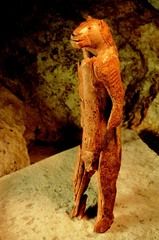
|
Lion-Man from Hohlenstein, Germany, c. 30,000-26,000 BC, Paleolithic; do not know why it was created; fairly realistic for time period even though the animal does not exist in real life
|
|
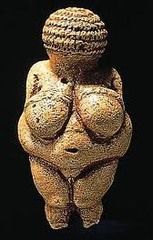
|
“Venus” from Willendorf, Austria, c. 24,000 BC, Paleolithic; prehistoric; most likely is portraying sex and fertility bc she has very emphasized female body parts and her face is not shown; this is not certain because it is prehistoric
|
|
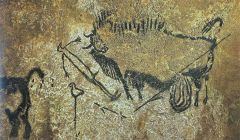
|
Bird-headed Man, Lascaux, France, c. 15,000 BC, Paleolithic
|
|
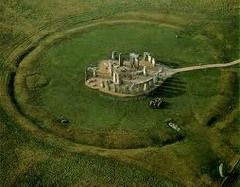
|
Stonehenge, Salisbury Plain, England, c. 2900-1500 BC, Neolithic; prehistoric; giant stone calendar; aligns with solstice; henge means circle, name means stone circle; some think that it has to do with the city of the dead since it is a circle; most likely relates to agriculture; columns are made out of ... style
|
|

|
Stele of Naram-Sin, Iraq, c. 2220 BC, Akkadian; uses hieratic scale; king is also located at the top of slab, closer to heave; captures a war scene, trying to make king appear heroic
|
|
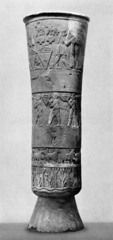
|
Uruk Vase, from Warka, Iraq, c. 3300-3000 BC, Sumerian; from a period where history was recorded so we know the figures are gods and goddesses; uses different levels; the higherr level you were on or the bigger you were means the more important you were
|
|
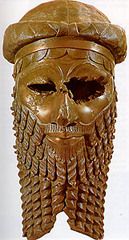
|
Akkadian Ruler, Iraq, c. 2250 BC, Akkadian
; made from long lasting bronze material, meant that they wanted their king to have a long lasting memory; beard, hair, and eyebrows are extremely organized and not life like; they are more perfected than realistic, represents the fact that he is a king and not a normal/average person; face is damage (eye is poked out) someone possibly was trying to get back at the king? |
|
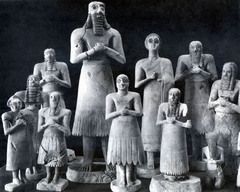
|
Votive figures, from Eshnunna, Iraq, c. 2900-2600 BC, Sumerian; they have very large eyeballs because they were worshipping, so their features are exaggerated in order to show that they are focused in prayer; artist knew the eyes weren't that big; example of form relating to the function of the object; votive statue
|
|
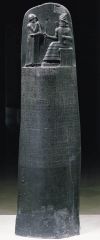
|
38 Stele of Hammurabi, c. 1750 BC, Babylonian; purpose of stone is to representing kindness, shown by a god who is handing his staff off to a king; mixing of religion and government; figures are located at the top of the slab because they are the most important figures
|
|

|
Assurnasirpal II killing Lions, Kalhu, Iraq, c. 870 BC, Assyrian; king is surrounded by servants and lions, the lions are attacking however the king is the only one fighting them off; makes him appear as a fierce and brave leader; *typical depiction of Syrian art- see repetition in narrative pieces; it is always carved very delicatly; always shows very fierce war-like scenes
|
|
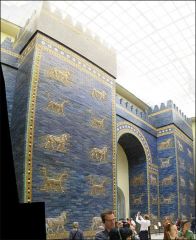
|
Ishtar Gate and Palace of Nebuchadnezzar II, Babylon, Iraq, mid-6th century BC, Neo-Babylonian; entrance to Babylon; tall gates with arch as entrance; could see the zigguat in the background as you entered the gate; made of mosiacs; shows lots of muscular animals on the gates, this is a way to make the culture seem tough bc when you enter through their gates, you see all of these fierce animals and it was supposed to frighten foreigners; *typical of culture to depict muscular animals in their art
|
|
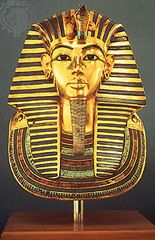
|
Funerary mask of Tutankhamun, c. 1330 BC, New Kingdom Egypt; continuity is a strong theme in Egyptian art until (middle period?); king tut became king at a very young age and some aristocrats stepped in to help him rule while he was young and they helped return some of the old kingdom characteristics to art (such as this gold mask); Tut was the son of Akhenaten
|
|
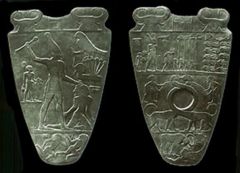
|
52, Palette of Narmer, c. 2950 BC, Old Kingdom Egypt; king is bigger than others (hieratic scale); falcon in upper right hand corner stands for upper Egypt; we know who the king is on the stone because we can read hieroglyphics; the use for this is a make up slab (example of form and function)
|
|
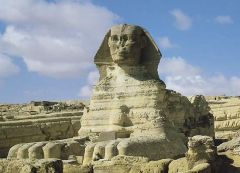
|
Sphinx of Khafre and Pyramids of Giza, c. 2500 BC, Old Kingdom Egypt; pyramids: biggest one built first, smallest built last; whole community comples (workshops, homes, etc) but pyramids are the biggest and most known features; made of stone (alsmost always use stone for pyramids bc it is long lasting and will commemorate their kings for a long time; pyramids went out of style quickly, built quickly and then went out of style; dead give away for treasure so they were often robbed; pyramids are from the old egyptian kingdom; Sphinx: attached to the 2nd biggest pyramid Chephren; sphinx is a hybrid animal, has the brains of a human and the body of a lion, guards the complex
|
|

|
Menkaure and Queen, c. 2480 BC, Old Kingdom Egypt; has rectiliniar/boxy approach due to heave medium that was used; traditional pharroh attire; king appears young, strong and calm, appears at his prime age; very realistic in terms of body proportions & musculature, except knee cap (square-ness) and leg is too long; king is shown with certain type of dignity so some features are exaggerated or perfected in order to portray this dignity- form is idealized
|
|
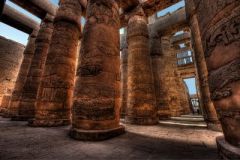
|
Hypostyle Hall, Temple of Amun, Karnak, c. 1200 BC, New Kingdom Egypt; post and lintel system; avenue of sphinxes opens up to a courtyard to the temple; very large in scale (length of multiple football fields); small columns on outside with bud capitals, large columns in center with papyrus capitals; center is taller in order to incorporate windows to add light
|
|
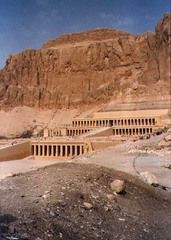
|
Funerary Temple of Hatshepsut, Deir el-Bahri, c. 1460 BC, New Kingdom Egypt; dedicated to Hatshepsut but she isn't burried here; surrounded by cliffs, they began to build temples and other important complexes into cliffs so they were not as noticable and easily robbed; axilaity and hierarchy are both present; very symmetrical complex; woman pharroh, how to fit herself into a man's role- she presents herself as previous rulers, wears pharroh hat, often portrayed as a sphinx to demonstrate power; ruled during the New Kingdom
|
|
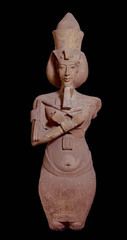
|
Colossal Statue of Akhenaten, c. 1350 BC, Amarna Period Egypt; king who tries not to portray himself the way other kings do, shows imperfect features in his depiction with family, trying to be more like his people; his wife is Nefertiti
|
|
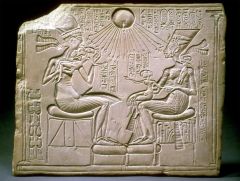
|
Akhenaten and his family, c. 1350 BC, Amarna Period Egypt; shows sun disk and blessing rays coming out to them; not muscular like the way other kings are portrayed; trying to portray royal family as related to the public and not as exaggerated as other kings
|
|
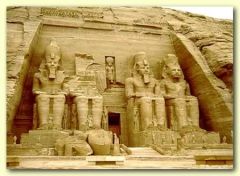
|
Temple of Ramses II, Abu Simbel, c. 1250 BC, New Kingdom Egypt; Rameses is going old school and capturing the glory and power of the old kingdom; giant statues of Rameses on either side of temple entrance (65 ft tall); he was to be remembered as the best and most powerful; referred to in the watchmen; carved into the side of a cliff; temples began to be built in hidden places like this so they weren't raided; Nile river is located right behind cliff
|
|
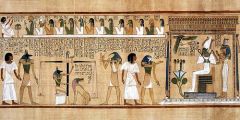
|
Hunefer before Osiris, c. 1285 BC, New Kingdom Egypt; judgement time; made on a papyrus script; starting on left, he is being brought in by the Jackel head (death guard) his heart is being weighed in the middle scene to determine if he will go to heaven, on right he is being judged
|
|
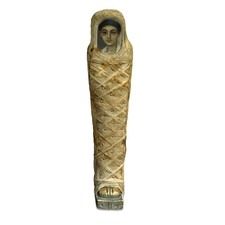
|
Boy Mummy, c. 100 AD, Roman Period Egypt; style of representation is much more realistic than other Egyptian styles
|
|
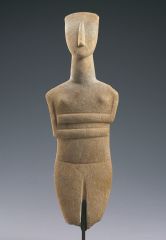
|
Figure of Woman, c. 2500 BC, Cycladic; they made many of these women statues; all look the same; do not emphasize breasts or other feminine parts, however you can still tell its a woman; very abstract (but its believed that they weren't trying to be abstract); originally had paint on them; abstraction could be due to the material used because it was so hard; typically laid on their sides bc they couldn't stand on their own; Cyclades were prehistoric so we do not know the true purpose of these
|
|
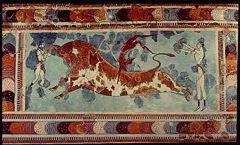
|
Bull Leaping, Knossos, Crete, c. 1500 BC, Minoan; demonstrates lively movement- typical of Minoan art; figures aren't very detailed but they are full of energy; very energetic art as opposed to Cycladic art (both Aegean civilizations); Cycladic art is not detailed and does not demonstrate any movement; they do not know how to capture the movement of animals yet; if people really attempted to ride bulls this way, they most certainly would have gotten hurt so it is plausible that this is how the myth of the minotaur began (people being sacraficed to the bull god)
|
|
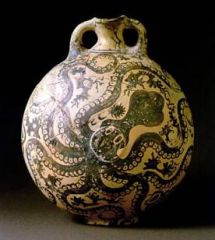
|
Octopus Flask, c. 1500 BC, Minoan; used a lot of marine life in their art because they are surrounded by water (on island); attention to movement (typical characteristic)
|
|

|
"Mask of Agamemnon," c. 1600 BC, Mycenean; supposed to be the god Agamemnon, however no one knows if that is true or if the archeologist who discovered it thought it was Agamemnon (he wasn't very thorough when excavating, and got many things mixed up; also do not know if dates match up correctly); a lot of religious and funerary art in culture
|
|
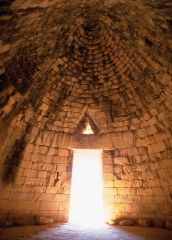
|
“Treasury of Atreus” Tholos, Mycenae, Greece, c. 1250 BC, Mycenean; isn't a treasury, its a tomb, interior is shapped like a cone (called corbeling:stepping out of stones) not a source of light due to this; it is one of the largest structures built without columns or support; Myceneans used a lot of corbeling in their architecture
|
|

|
Warrior Vase, c. 1200 BC, Mycenean; very different than other pieces because it was a time of war; soilders are all alike (almost like a stamp)
|
|
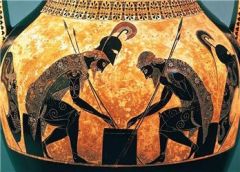
|
Achilles and Ajax vase by Exekias, c. 540, Greek Archaic; Exekias the artist makes pieces that are focused on composition; he makes dark pieces that are very heavy, monumental, powerful; captures very intense scenes, lots of killing; even in this scene, they are playing a game, yet they have their weapons in hand as if the mood could turn violent at any moment
|
|
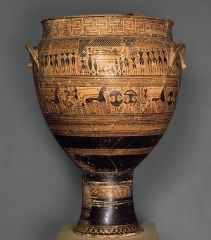
|
Funerary Krater, from Dipylon Cemetery, Athens, c. 700 BC, Greek Geometric; from the geometric period; in this scen we see people standing around a funeral (influenced by Egyptian art); geometric era did not last long; shows humans using shields as their bodies; scene is depicting a funeral; women are shown around dead person as they mourn- can tell bc they show the breasts slightly
|
|
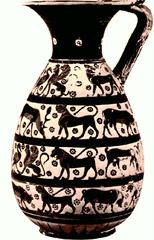
|
Pitcher from Corinth, c. 650 BC, Greek Orientalizing; moving on from geometric period to oriental period; some similar styles to ones in Iraq due to trading;
|
|
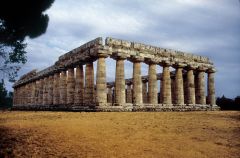
|
Temple of Hera I, Paestum (Italy), c. 550 BC, Greek Archaic; uses Doric columns, also fluted columns, they are wide at the bottom and smaller at the top (gives stability), columns appear to have swelling (sides are not flat), the columns are based on human proportions, bolder columns are thick and chubby but eventually evolve to become skinnier and more idealized (goes along with how the human form evolves in Greek art); post and lintel system
|
|
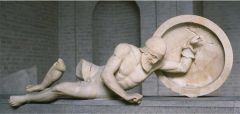
|
Dying Warrior from Aegina, c. 490 BC, Greek Archaic/Early Classical; comparison to the quirky Archaic soilder who is being shot with an arrow, this one shows much more emotion, shows that Greeks are developing their art even further to portray motion/emotion; this statue isn't exactly realistic but it is beginning to capture a sense of emotion even though he doesn't have that real of features (beard is flat, no defined hair); lively expression like he is in pain
|
|

|
Metropolitan Museum Kouros, c. 600 BC, Greek Archaic; he is about to take a step; artist was observant of which muscles are being used, shows movement before it happens (typical archaic characteristic), shows weight shift- compared to Egyptian statue of queen and king, this one is more realistic because his leg is not too lengthy; shows that they were beginning to successfully capture body proportions, but they have not fully developed motion or emotion; beginning to lose quirky Archaic smile
|
|

|
Peplos Kore, c. 530 BC, Greek Archaic;
|
|

|
Warrior from Riace, c. 460 BC, Early Classical; made of bronze but has copper for lips and eyes; he is a warrior, not a god; shows how they are beginning to represent their gods in human form and its hard to tell the difference between gods and humans which is very different from other cultures; he appears to be in the middle of shifting his weight; they are still working on fully depicting movement- haven't gotten there yet though bc they are still in the stage of showing a movement before it happens
|
|
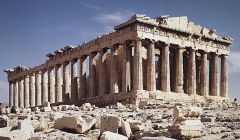
|
The Parthenon, Athens, by Kallikrates and Iktinos, c, 440 BC, High Classical; part of an acropolis (high city up in air); temple of Athena was built into the Parthenon bc the orginal one was destroyed by war; located in Athens (thought of as the first modern democracy); when you walk into the gates you see the Parthenon off to the side (different type of layout compared to the Egyptians who put their main features such as pyramids in the direct center); made up of Doric columns with cushions; corner columns are fatter and not spread out as far from the others; looks perfectly organized but it is not, has lots of problems; would have originally been painted brightly
|
|
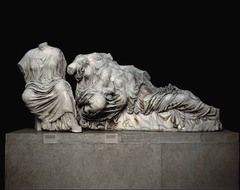
|
Goddesses from East Pediment of the Parthenon, by Pheidiea, c. 440 BC, High Classical; very realistic sculpture; anatomically correct; located at the roofed triangle part of the parthenon; now located in London and Greeks want it back; movement and motion is extremely noticeable even though we can not see faces, shown through body composition; clothing is very detailed and perfected
|
|
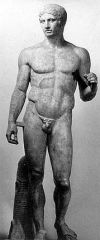
|
Doryphorus by Polykleitos, c. 450 BC, Early Classical; made of stone; very famous bc it is supposed to represent Polykleitos' idea of perfection and proportions (in relation to eachother) the Greeks continue to further this however bc this figure is slightly chubby, human figures start to become slimer
|
|

|
Doryphorus by Polykleitos, c. 450 BC, Early Classical; made of stone; very famous bc it is supposed to represent Polykleitos' idea of perfection and proportions (in relation to eachother) the Greeks continue to further this however bc this figure is slightly chubby, human figures start to become slimer
|
|
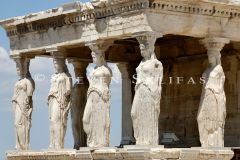
|
Erechteion with Porch of Maidens, Athens, c. 420 BC, High Classical; very complicated temple
|
|
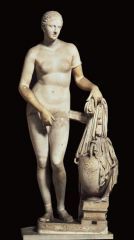
|
Aphrodite of Knidos, by Praxiteles, c. 350 BC, Late Classical; first statue of Venus that is nude; evolution of the goddesses being portrayed nude: her clothes begun to get more and more transluscent and eventually she began to be portrayed with nothing at all (starting with this piece);
|
|
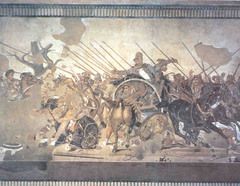
|
Battle of Issos, originally by Philoxenes or Helen of Egypt, c. 310 BC, Hellenistic; pictures Alexander the Great; horse is running away; shows the scene as if it is happening with the viewer within it- right in the middle of the action; characteristic of the Hellenistic art style, puts the viewer right within the action
|
|
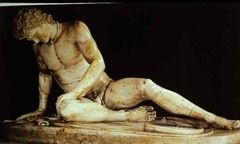
|
Dying Gallic Trumpeter, possibly by Epigonos, from Pergamon, c. 220 BC, Hellenistic; almost naked except for necklace; he is dying but still holding himself upright; dramatic and emotional; you can feel his pain by the emotions in his face, his spirit is strong even though his body is failing; have to walk around to get the full effect of this statue; he is hunched over; full rounded figure, no longer flat styles at all; fact that you have to walk around the statue relates to the fact that Hellenistic art is very interactive
|
|
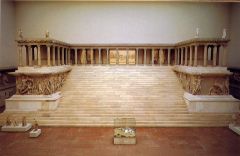
|
Altar of Zeus, Pergamon, c. 160 BC, Hellenistic; excavated by German scholars; now located in Berlin; uses ionic order; forms a U shape and has arms that gather you in; also has stairs that invite you in, much more interactive with viewer; sculpture on the staircase of temple is very defined and shows detailed musculature; the sculptures are resting on the stairs almost as if the war scene is coming out into your space - interactive hellenistic characteristic
|
|
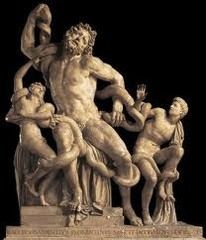
|
Laocoön and his sons, by Hagesandros et al., c. 0, Hellenistic; Trojan War story; angered the gods so they punished him with snakes; each character is individually realistic, but it is not very realistic all together; adult sons would not be this much smaller than their father just because they are younger; Hellenistic style captures movement while it is happening, not before it happens
|
|
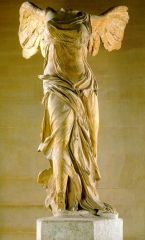
|
Nike of Samothrace, c. 180 BC, Hellenistic; winged Victory; you can see motion bc she is goddess of victory; commemorated for Naval victory therefore she is positioned on the bow of a ship; wind is blowing back her clothing- it is almost plastered to her body and flowing backwards; characteristics: motion, detail, story relation
|
|
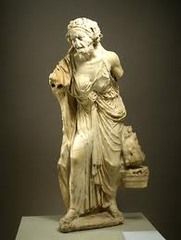
|
Old Woman, Roman copy c. 0, Hellenistic; her appearance has been captured beautifully and realistically even though her looks are not exactly beautiful; captures her true features; Hellenistic characteristic- another example is the seated boxer, he may not be handsome, but it shows him in his true colors
|

